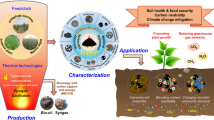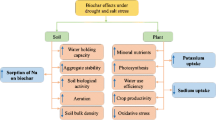Abstract
Typha angustifolia, Juncus maritimus, and Eleocharis palustris were evaluated for de-icing salt removal from runoff water. Plants were exposed to a range of de-icing salt levels (0.2, 0.7, 4, 8, and 13 dS m−1) in laboratory-scale subsurface constructed wetlands (CWs) for 2 months under greenhouse conditions. Effluent characteristics, plant height, biomass, and Cl and Na removal rates and uptake were monitored. More water volume was retained in CWs of T. angustifolia (∼60 %) than of J. maritimus and E. palustris (∼37.5 %), which accounted for the electrical conductivity increase in effluents (1.3–1.9-fold). Based on the NaCl removal rate, T. angustifolia showed the greatest phytodesalinization ability (31–60 %) with the highest removal at the lowest salt levels (0.2–0.7 dS m−1), followed by J. maritimus (22–36 %) without differences in removal among levels, and E. palustris (3–26 %) presenting a removal rate highly decreased with increasing salt levels. Plant height and biomass were stimulated at low de-icing salt levels, but, at higher levels, T. angustifolia and E. palustris growth was inhibited (tolerance index ∼67 and 10 %, respectively, in the worst cases). Salt amounts in aboveground biomass in g m−2 differed among levels and ranged as follows: 13.6–29.1 (Cl), 4.2–9.3 (Na; T. angustifolia); 7.0–12.0 (Cl), 2.7–6.4 (Na; J. maritimus); and 0.9–7.6 (Cl), 0.3–1.6 (Na; E. palustris). Chloride and Na translocation decreased with de-icing salt increase in T. angustifolia, while no significant differences were found in J. maritimus, which is interesting for harvesting purposes.





Similar content being viewed by others
References
Abdu N, Agbenin JO, Buerkert A (2011) Phytoavailability, human risk assessment and transfer characteristics of cadmium and zinc contamination from urban gardens in Kano, Nigeria. J Sci Food Agric 91:2722–2730. doi:10.1002/jsfa.4583
Afnor (2003) Chlorure de sodium solide utilisé comme fondant routier. Norme française. NF P98–180 (in French)
Almeida CMR, Mucha AP, Vasconcelos MTSD (2006) Variability of metal contents in the sea rush Juncus maritimus-estuarine sediment system through one year of plant’s life. Mar Environ Res 61:424–438. doi:10.1016/j.marenvres.2005.12.002
Bäckström M, Karlsson S, Bäckman L, et al. (2004) Mobilisation of heavy metals by deicing salts in a roadside environment. Water Res 38:720–732. doi:10.1016/j.watres.2003.11.006
Blomqvist, G (2001) De-icing salt and the roadside environment. PhD thesis. Division of Land and Water Resources, Department of Civil and Environmental Engineering, Royal Institute of Technology, Stockholm, Sweden, 32 pp
Boscaiu M, Lull C, Llinares J, et al. (2013) Proline as a biochemical marker in relation to the ecology of two halophytic Juncus species. J Plant Ecol 6:177–186. doi:10.1093/jpe/rts017
Boscaiu MG, Naranjo MA, Vicente O, Boira H (2007) Responses of halophytes to salt stress. Bull Univ Agric Sci Vet Med Cluj-Napoca Anim Sci Biotechnol 63–64:1–6
Brown JJ, Glenn EP, Fitzsimmons KM, Smith SE (1999) Halophytes for the treatment of saline aquaculture effluent. Aquaculture 175:255–268. doi:10.1016/S0044-8486(99)00084-8
Caselles-Osorio A, Garcia J (2007) Effect of physico-chemical pretreatment on the removal efficiency of horizontal subsurface-flow constructed wetlands. Environ Pollut 146:55–63. doi:10.1016/j.envpol.2006.06.022
CEAEQ (Centre d’Expertise en Analyse Environnementale du Québec) 2012 Modes de conservation pour l’échantillonnage des eaux de surface, DR-09-10, Ministère du Développement durable, de l’Environnement et des Parcs, 7 pp (in French)
Coleman J, Hench K, Garbutt K, et al. (2001) Treatment of domestic wastewater by three plant species in constructed wetlands. Water 128:283–295. doi:10.1023/A:1010336703606
Cooper C A., Mayer PM, Faulkner BR (2014) Effects of road salts on groundwater and surface water dynamics of sodium and chloride in an urban restored stream. Biogeochemistry 1–18. doi:10.1007/s10533-014-9968-z
Engelhard C, De Toffol S, Lek I, et al. (2007) Environmental impacts of urban snow management—the alpine case study of Innsbruck. Sci Total Environ 382:286–294. doi:10.1016/j.scitotenv.2007.04.008
Ennabili A, Atere M (2005) Diversité floristique et production de biomasse des macrophytes des marais de Smir. In: Bayed A, Scapini S (eds) Écosystèmes côtiers sensibles la Méditerranée cas du littoral Smir. Trav. l’Institut Sci. Rabat, série générale, no 4. pp 17–25 (in French)
Ennabili A, Atere M, Radoux M (1998) Biomass production and NPK retention in macrophytes from wetlands of the Tingitan peninsula. Aquat Bot 62:45–56. doi:10.1016/S0304-3770(98)00075-8
Environment and Health Canada (2001) Canadian Environmental Protection Act, 1999. Priority Substances List Assessment Report. Road Salts. 171 pp
Exall K, Rochfort Q, Marsalek J (2011) Measurement of cyanide in urban snowmelt and runoff. Water Qual Res J Can 46:137–147. doi:10.2166/wqrjc.2011.022
Galvez R, Leroueil S, Triffault-Bouchet G et al. (2010) Natural geo-filter bed and halophyte wetland: an eco-engineering system to mitigate saline highway runoff impacts. IASTED Technol. Conf.
Galvez-Cloutier R, Triffaut-Bouchet G, Roy S (2014) Eco-engineering process for the treatment of contaminants from salted highway runoff: adapted wetland and active filter. 11th Int. Conf. Phytotecnologies. Heraklion, Crete, Greece, p4
Godwin KS, Hafner SD, Buff MF (2003) Long-term trends in sodium and chloride in the Mohawk River, New York: the effect of fifty years of road-salt application. Environ Pollut 124:273–281. doi:10.1016/S0269-7491(02)00481-5
Gottschall N, Boutin C, Crolla A, et al. (2007) The role of plants in the removal of nutrients at a constructed wetland treating agricultural (dairy) wastewater, Ontario, Canada. Ecol Eng 29:154–163. doi:10.1016/j.ecoleng.2006.06.004
Guesdon G, Galvez R (2012) Faisabilité de transposition des unités de lit filtrant et marais conçus par U. Laval à des conditions françaises. Partie 2: Essaies en vue de la conception du lit filtrant réactif et du marais épurateur construit adapté. Raport technique. Université Lav. Université Laval. Québec. Canada, 79 pp (in French)
Guesdon G, Galvez-Cloutier R, Triffault-Bouchet G (2013) Evaluation pilote d’un marais épurateur construit adapté et d’un lit filtrant réactif pour le traitement du ruisellement routier: Suivi de l’écosystème et résultats de performance. Rapport final. Université Laval, 154 pp (in French)
Guittonny-Philippe A, Masotti V, Höhener P, et al. (2014) Constructed wetlands to reduce metal pollution from industrial catchments in aquatic Mediterranean ecosystems: a review to overcome obstacles and suggest potential solutions. Environ Int 64:1–16. doi:10.1016/j.envint.2013.11.016
Hargreaves GH, Asce F, Allen RG (2003) History and evaluation of Hargreaves evapotranspiration equation. Irrig Drain Eng:53–63. doi:10.1061/(ASCE)0733-9437(2003)129:1(53)
Hoffman RW, Goldman CR, Paulson S, Winters GR (1981) Aquatic impacts of deicing salts in the central sierra Nevada Mountains, California. J Am Water Resour Assoc 17:280–285. doi:10.1111/j.1752-1688.1981.tb03935.x
Howard RJ, Mendelssohn IA (1999) Salinity as a constraint on growth of oligohaine marsh macrophytes. II. Salt pulses and recovery potential. Am J Bot 86:795–806. doi:10.2307/1816011
Jacques, S (2008) Guide de contrôle et d’assurance de la qualité du chlorure de sodium (in French)
Jing SR, Lin YF, Lee DY, Wang TW (2001) Nutrient removal from polluted river water by using constructed wetlands. Bioresour Technol 76:131–135. doi:10.1016/S0960-8524(00)00100-0
Jordan TE, Whigham DF, Hofmockel KH, Pittek MA (2003) Nutrient and sediment removal by a restored wetland receiving agricultural runoff. J Environ Qual 32:1534–1547. doi:10.2134/jeq2003.1534
Khan MA, Gul B, Weber DJ (2002) Effect of salinity on the growth and ion content of Salicornia rubra. Commun Soil Sci Plant Anal 32:2965–2977. doi:10.1081/CSS-120000975
Lee B-H, Scholz M (2007) What is the role of Phragmites australis in experimental constructed wetland filters treating urban runoff? Ecol Eng 29:87–95. doi:10.1016/j.ecoleng.2006.08.001
Legret M, Pagotto C (1999) Evaluation of pollutant loadings in the runoff waters from a major rural highway. Sci Total Environ 235:143–150. doi:10.1016/S0048-9697(99)00207-7
Li F, Zhang Y, Fan Z, Oh K (2015) Accumulation of de-icing salts and its short-term effect on metal mobility in urban roadside soils. Bull Environ Contam Toxicol 94:525–531. doi:10.1007/s00128-015-1481-0
Liu J, Dong Y, Xu H, et al. (2007) Accumulation of Cd, Pb and Zn by 19 wetland plant species in constructed wetland. J Hazard Mater 147:947–953. doi:10.1016/j.jhazmat.2007.01.125
Löfgren S (2001) The chemical effects of deicing salt on soil and stream water of five catchments in southeast Sweden. Water Air Soil Pollut 130:863–868. doi:10.1023/A:1013895215558
Lymbery AJ, Doupé RG, Bennett T, Starcevich MR (2006) Efficacy of a subsurface-flow wetland using the estuarine sedge Juncus kraussii to treat effluent from inland saline aquaculture. Aquac Eng 34:1–7. doi:10.1016/j.aquaeng.2005.03.004
Miklovic S, Galatowitsch SM (2005) Effect of NaCl and Typha angustifolia L. on marsh community establishment: a greenhouse study. Wetlands 25:420–429. doi:10.1672/16
Ministère des transports du Québec (2011) Norme, Tome VII, Chapitre 12. Chlorure de sodium (in French)
Mitchell LK, Karathanasis AD (1995) Treatment of metal-chloride-enriched wastewater by simulated constructed wetlands. Environ Geochem Health 17:119–126. doi:10.1007/BF00126080
Morteau B, Galvez-Cloutier R, Leroueil S (2006) Développement d’une chaîne de traitement pour l’atténuation des contaminants provenant des sels de voiries de l’autoroute Félix-Leclerc: lit filtrant et marais épurateur construit adapté. Raport technique. Université Laval. Québec. Canada (in French)
Morteau B, Triffault-bouchet G, Galvez R, Martel L (2015) Nutrient and removal kinetics impacts on salt phytoremediation by Atriplex patula and Typha angustifolia. J Environ Eng 141:1–8. doi:10.1061/(ASCE)EE.1943-7870.0000889.
Naidoo G, Somaru R, Achar P (2008) Morphological and physiological responses of the halophyte, Odyssea paucinervis (staph) (Poaceae), to salinity. Flora 203:437–447. doi:10.1016/j.flora.2007.08.003
Nilratnisakorn S, Thiravetyan P, Nakbanpote W (2009) A constructed wetland model for synthetic reactive dye wastewater treatment by narrow-leaved cattails (Typha angustifolia Linn.). Water Sci Technol 60:1565–1574. doi:10.2166/wst.2009.500
Norrström AC (2005) Metal mobility by de-icing salt from an infiltration trench for highway runoff. Appl Geochem 20:1907–1919. doi:10.1016/j.apgeochem.2005.06.002
Norrström A-C, Bergstedt E (2001) The impact of road de-icing salts (NaCl) on colloid dispersion and base cation pools in roadside soils. Water Air Soil Pollut 127:281–299. doi:10.1023/A:1005221314856
Novotny EV, Stefan HG (2012) Road salt impact on lake stratification and water quality. J Hydraul Eng 138:1069–1080. doi:10.1061/(ASCE)HY.1943-7900.0000590
Paschka MG, Ghosh RS, Dzombak DA (1999) Potential water-quality effects from iron cyanid anticaking agents in road salt. Water Environ Res 71:1235–1239. doi:10.2175/106143096X122410
Peltre MC, Muller S, Dutartre A, Barbe J (1997) Macrophytes des eaux continentales. Biol. écologie des espèces végétales proliférant en Fr. Synthèse Bibliogr. Les études l’agence l’eau N°68, 199 pp (in French)
Ramakrishna DM, Viraraghavan T (2005) Environmental impact of chemical deicers—a review. Water Air Soil Pollut 166:49–63. doi:10.1007/s11270-005-8265-9
Rémi S, Ivana D, Guillaume D, et al. (2013) Transfer, exchanges and effects of road deicing salts in a detention pond treating road water. Energy Procedia 36:1296–1299. doi:10.1016/j.egypro.2013.07.147
Roy, S (2015) Traitement du ruissellement routier chargé en sels de déglaçage au moyen de plantes halophytes par marais épuration. MSc Thesis, in process. Laval University, Quebec, Canada, 150 pp (in French)
Rozema, ER (2014) Can plants be used to remove Na+ and Cl− from nutrient solution in greenhouse production? PhD Thesis. University of Guelph, Ontario, Canada, 73 pp
Shabala S, Mackay A (2011) Ion transport in halophytes. Adv Bot Res:151–199. doi:10.1016/B978-0-12-387692-8.00005-9
Shelef O, Gross A, Rachmilevitch S (2013) Role of plants in a constructed wetland: current and new perspectives. Water 5:405–419. doi:10.3390/w5020405
Sindilariu PD, Schulz C, Reiter R (2007) Treatment of flow-through trout aquaculture effluents in a constructed wetland. Aquaculture 270:92–104. doi:10.1016/j.aquaculture.2007.03.006
Terzakis S, Fountoulakis MS, Georgaki I, et al. (2008) Constructed wetlands treating highway runoff in the central Mediterranean region. Chemosphere 72:141–149. doi:10.1016/j.chemosphere.2008.02.044
Touchette BW (2006) Salt tolerance in a Juncus roemerianus brackish marsh: spatial variations in plant water relations. J Exp Mar Biol Ecol 337:1–12. doi:10.1016/j.jembe.2006.05.011
Tromp K, Lima AT, Barendregt A, Verhoeven JTA (2012) Retention of heavy metals and poly-aromatic hydrocarbons from road water in a constructed wetland and the effect of de-icing. J Hazard Mater 203-204:290–298. doi:10.1016/j.jhazmat.2011.12.024
Acknowledgments
This research was supported by the Autoroute du Sud de la France Company. The authors especially wish to thank Magali Lambert, Francesco Fusai, and Michel Bisping for his laboratory assistance. We thank the Editor and the anonymous referees for their helpful suggestions.
Author information
Authors and Affiliations
Corresponding author
Additional information
Responsible editor: Yi-ping Chen
Rights and permissions
About this article
Cite this article
Guesdon, G., de Santiago-Martín, A. & Galvez-Cloutier, R. Phytodesalinization potential of Typha angustifolia, Juncus maritimus, and Eleocharis palustris for removal of de-icing salts from runoff water. Environ Sci Pollut Res 23, 19634–19644 (2016). https://doi.org/10.1007/s11356-016-7176-1
Received:
Accepted:
Published:
Issue Date:
DOI: https://doi.org/10.1007/s11356-016-7176-1




